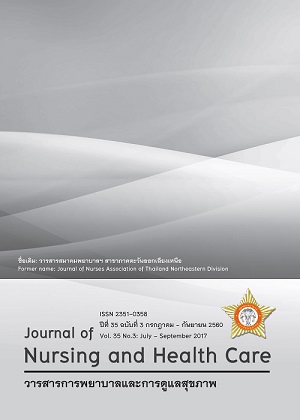ผลของโปรแกรมพัฒนาพฤติกรรมป้องกันโรคหลอดเลือดสมอง ของผู้ป่วยกลุ่มเสี่ยง จังหวัดกาญจนบุรี Effects of Preventive Behavior Developing Program for Patients with Cerebrovascular Disease Risk at Kanchanaburi Province
คำสำคัญ:
โปรแกรม พฤติกรรมป้องกันโรค โรคหลอดเลือดสมอง Program, Preventive behavior, Cerebrovascular diseaseบทคัดย่อ
บทคัดย่อ
การวิจัยกึ่งทดลองแบบมีกลุ่มควบคุมนี้ มีวัตถุประสงค์เพื่อเปรียบเทียบความแตกต่างของความรู้ การรับรู้เกี่ยวกับโรคหลอดเลือดสมอง พฤติกรรมป้องกันโรคหลอดเลือดสมอง และความดันโลหิตในผู้ป่วยโรคความดันโลหิตสูงชนิดไม่ทราบสาเหตุ ที่มีภาวะเสี่ยงต่อโรคหัวใจและหลอดเลือดในระดับต่ำและปานกลาง ที่ได้รับโปรแกรมพัฒนาพฤติกรรมป้องกันโรคหลอดเลือดสมองตามแนวคิดแบบจำลอง พรีสีด-โพรสีด ที่มารับบริการที่คลินิกโรคเรื้อรัง โรงพยาบาลส่งเสริมสุขภาพตำบลบ้านม่วงชุม อำเภอท่าม่วง จังหวัดกาญจนบุรี คัดเลือกตามเกณฑ์เป็นกลุ่มทดลอง จำนวน 30 คน และผู้ป่วยที่มีลักษณะคล้ายคลึงกันที่มารับบริการที่คลินิกโรคเรื้อรัง โรงพยาบาลส่งเสริมสุขภาพตำบลบ้านเขาดิน อำเภอท่าม่วง จังหวัดกาญจนบุรีเป็นกลุ่มควบคุม จำนวน 34 คน
ผลการวิจัย พบว่า กลุ่มทดลอง มีความรู้ และการรับรู้เกี่ยวกับโรคหลอดเลือดสมอง พฤติกรรมป้องกันโรคหลอดเลือดสมอง หลังการทดลองสูงกว่าก่อนการทดลอง (Z = -3.909, p= 0.000, Z = -2.811, p= 0.009 และ Z = -8.197, p = 0.000 ตามลำดับ) และมีความดันซีสโตลิกหลังการทดลองต่ำกว่าก่อนการทดลอง (Z = -2.783 , p = 0.005) อย่างมีนัยสำคัญทางสถิติที่ระดับ .05 หลังได้รับโปรแกรมพัฒนาพฤติกรรมป้องกันโรคหลอดเลือดสมอง กลุ่มทดลอง มีความรู้ การรับรู้เกี่ยวกับโรคหลอดเลือดสมอง และพฤติกรรมป้องกันโรคหลอดเลือดสมองสูงกว่ากลุ่มควบคุม (Z = -3.769, p= 0.000, Z = 4.563, p= 0.000 และ Z = 5.745, p = 0.000 ตามลำดับ) และมีความดันซีสโตลิกและไดแอสโตลิกต่ำกว่ากลุ่มควบคุม (Z = -3.583, p= 0.000 และ Z = -3.337, p= 0.001 ตามลำดับ) อย่างมีนัยสำคัญทางสถิติที่ระดับ.05
Abstract
The objectives of this quasi-experimental with control group research were to compare knowledge and perception about cerebrovascular disease, preventive behavior for cerebrovascular disease and blood pressure in essential hypertensive patients with low and moderate cardiovascular disease risk who received Preventive Behavior Developing Program based on the PRECEDE-PROCEED model. The experimental group (n=30) was who attended at the chronic disease clinic in Muangchum Subdistrict Health Promoting hospital, Thamuang District, Kanchanaburi Province, they were selected by criteria and the control group (n=34) was who have similar characteristics with experimental group who attended at the chronic disease clinic in Bankaodin Subdistrict Health Promoting hospital, Thamuang District, Kanchanaburi Province. The results found that: knowledge and perception about cerebrovascular disease, preventive behavior for cerebrovascular disease of the experimental group after the experiment were significantly higher than before (Z=-3.909, p=0.000, Z= -2.811,p=0.009 and Z= -8.197, p = 0.000respectively), as well as systolic blood pressure of the experimental group after the experiment was significantly lower than before (Z=-2.783,p= 0.005). After the experiment, knowledge and perception about cerebrovascular disease, preventive behavior for cerebrovascular disease of the experimental group were significantly higher than the control group (Z=-3.769,p=0.000,Z=4.563, p= 0.000andZ=5.745,p=0.000respectively), while systolic and diastolic blood pressure of the experimental group were significantly lower than the control group (Z=-3.583, p=0.000and Z=-3.337, p=0.001 respectively).


